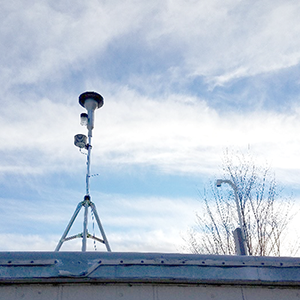Air quality monitoring at DEQ

The Oregon DEQ is a regulatory agency whose job is to protect and enhance the quality of Oregon's environment. In support of that mission, the Air Quality Monitoring Section of the DEQ’s Laboratory and Environmental Assessment Division is responsible for providing accurate scientific data concerning Oregon’s air quality. DEQ ensures that the state meets the National Ambient Air Quality Standards for criteria pollutants as required by the Federal Clean Air Act. The agency also monitors hazardous air pollutants (or air toxics) to track trends and presents near real time air quality data to inform public health decisions.
DEQ measures air pollutant levels by operating a network of air monitoring and sampling equipment at more than 40 sites throughout the Oregon. These sites are operated and maintained by DEQ air monitoring technicians with the goal of collecting complete and accurate air quality data. The equipment at an air monitoring station can vary from a complex array of continuous monitors operating 24 hours a day year-round to a single sampler with a filter that captures particulates once a week. Meteorological data provides important information to determine the sources and transport of air pollutants. Most of the data collected from the air monitoring network is submitted to the U.S. Environmental Protection Agency database for use in determining air pollution trends and air quality compliance with the NAAQS standards.
Each year, DEQ updates our Air Quality Monitoring Network Plan and submits it to the public for comment on June 1. The agency includes those comments and our responses, and submits the plan to the U.S. EPA for approval on July 1.
Every year DEQ publishes the Air Quality Monitoring Annual Report to include the most recent full year of monitoring data. It includes trends, annual AQI information, and regulatory violation data.
Criteria pollutants
DEQ monitors for
Federal Clean Air Act pollutants including carbon monoxide (CO), nitrogen dioxide (NO2), ozone (O3), sulfur dioxide (SO2), fine particulate (PM10 and PM2.5), and lead (Pb). Other pollutants or compounds are measured as part of air toxics or particulate speciation sampling.
Fine particulates are of particular concern in the Western United States, especially with smoke incursions from recent wildfire events. DEQ’s
Air Quality Index web page and the OregonAir mobile application for
Apple or
Android devices provide near real time information on the air quality throughout the state.
The agency also provides monitoring and technical assistance in support of the following AQ monitoring projects and studies:
- Visibility Network - Speciation and particulate monitors are located in federally designated wilderness areas and national parks to enhance visibility in these sensitive airsheds.
- Forest Health Network - Particulate monitors operate in areas of southwest and& northeast Oregon to assess smoke from controlled burns on federal lands in cooperation with the US Forest Service and the Bureau of Land Management.
- Local wood stove advisory and pollution prevention programs – DEQ works with the National Weather Service to forecast air stagnation events that can result in the accumulation of wood smoke and unhealthful air quality. DEQ works with local health agencies to inform the public and recommend steps citizens can take to proactively reduce air emissions. DEQ has developed a statewide wood stove program to promote the use of cleaner burning wood stoves, and help homeowners burn more efficiently and with less pollution
Air toxics
An area of increasing interest is the monitoring of
air toxics or hazardous air pollutants. Air toxics are air pollutants known or suspected to cause cancer or other serious health problems. DEQ has permanent air toxics monitoring trend sites and rotating air toxics monitoring assessment sites. DEQ prioritizes where air toxics monitors are placed using several criteria. These are discussed in the following three documents:
PM2.5 sensors
DEQ has received funding from the Oregon legislature to add 30 more PM2.5 Air Quality Index sites around the state. The agency developed the new, low-cost sensor technology that enabled us to add these sites. For more information on these sites, see the following documents.
DEQ and other groups are conducting research to learn more about air quality sensor technology. The accuracy and usefulness of air monitoring data is dependent on how the data are collected and validated. For more information, see the following documents.